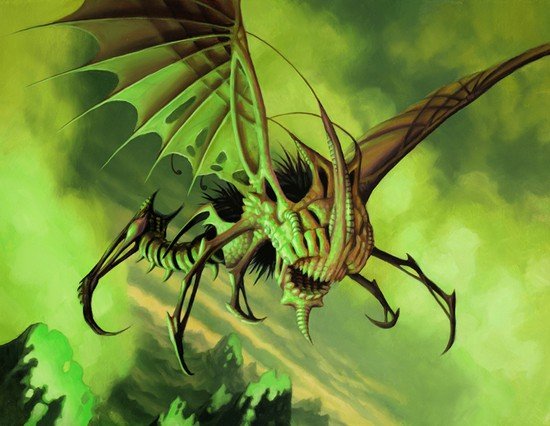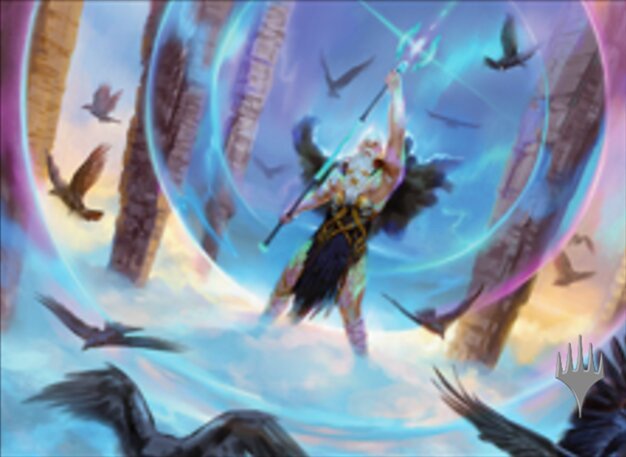One of the biggest problems with an established Metagame is predictability.
In Modern, when you see a mountain and a Monastery Swiftspear in the first turn you already know everything that is going to happen. Opponent starts with a Urza's Tower? You already know that you have to take Sideboard's Damping Sphere and pray that he doesn't cast a Karn Liberated before.
This predictability is very common, especially in more competitive scenarios. In serious events, in person or not, it is not just your fun that is at stake in each game, favoring those who use strategies and cards with a higher winning rate and predominance in the game environment. After all, at the end of the day a Breeding Pool does the same as a Hinterland Harbor, generating blue or green mana. But the first one is not only searchable with fetchlands, but it also has a better chance of being useful early in the game, favoring the development of your plan. This is reflected not only in the prices but in the usability of both in large and medium sized tournaments.
Ad
So, although many players don't really like the predictability of the metagame, claiming that it undermines some of the best qualities of a game with more than twenty thousand cards available to build their deck, it cannot be denied that it is the safest way to have tournament success, increasing your chances of winning prizes and seats to larger events.
But there are still those who try to test news on decks and make clay happen, playing in tournaments and leagues with their distillations of pure madness. A good idea for those who still want to use effective and proven game formulas but still want to feel that taste of adventure and novelty is to start subverting some pre-existing idea. And an eccentric enough idea to demonstrate this is by making changes to the Infect, an extremely aggressive deck that normally uses a blue and green base. In this article, we will explore Infect with the addition of Black mana instead of Blue mana.
The list below is from the player RAGNARBOY and produced good results in the Magic Online leagues last year and is one of the most successful attempts to use Infect with the color of black mana.
Infect is a deck that relies on the mechanics of the same name from the Nova Phyrexia set, its text is as follows; "This creature deals damage to creatures in the form of -1 / -1 counters and to players in the form of poison counters." On the one hand, it looks like the “Wither” mechanic coming from Lorwyn's block, which caused the damage caused by the creature with the ability for another creature to deposit -1 / -1 counters instead of damage, permanently weakening it. But our focus is on poison counters. A kind of counters that stay on the player and can be deposited on him in several different ways. What is the great advantage of placing this type of counter on opponents? When a player accumulates ten poison counters he loses the game.
For years, the use of poison counters was extremely complicated, as it was usually done fractionally, in small to small quantities. The most recent example of using Poison is Kaldheim's Fynn, the Fangbearer, which causes each creature with Deathtouch to add two counters when connecting combat damage to an opponent, thus needing five creatures with Deathtouch dealing combat damage throughout the game. It may seem like a quick thing, but Infect is even more so. A creature with this ability translates its damage into poison counters, that is, a 5/5 with Infect does not deal five damage to the opponent, but adds five poison counters. Therefore, Infect decks are built to be able to deal ten damage, or something similar, in a single attack, so that they become a mixture of aggro and combo.

The main reason for moving towards the use of Black is the presence of the Phyrexian Crusader. Despite having a more expensive mana cost than your standard creatures with Infect, this creature comes loaded with three very precious abilities that make up for the biggest flaw in Infect, the inability to protect the creatures themselves. With the protection against white and red given by this creature we can easily protect it from Burn decks, a somewhat doubtful match for the traditional Infect, being both its creatures and its instant damage spells, as well as protecting ourselves from white removal, more easily illustrated by the ever-present Path to Exile and the recent Skyclave Apparition. In addition, if a creature of another color blocks it, we can always count on its First Strike ability. In creatures with Infect, damage is dealt in the form of -1 / -1 counters, plus the Crusader's First Strike, we can guarantee many extremely favorable exchanges for him and even the destruction of the opponent's indestructible creatures. This creature is undoubtedly the driving force of the Black and Green Infect, and the main responsible for the change in the deck.
Ad

We also have as a novelty in the field of creatures the Plague Stinger, a two-mana card with evasion that seeks to replace the Blighted Agent. Although not as efficient as its blue counterpart, this creature is undoubtedly a great addition to the deck, taking full advantage of the new color. The other permanents of this type present here come from the traditional green base of Infect. Glistener Elf is your one drop and can work miracles, bringing victories out of nowhere in very early turns of the game. Noble Hierarch is here to speed up mana and bring an extra buff with her Exalted ability.
The last creature, in fact, is a manland, that is, a land that has an ability that transforms it into a creature. Inkmoth Nexus is a land that, in addition to generating colorless mana, also has the ability to become a 1/1 flying for 1 mana. Becoming yet another creature for your Infect army.

When it comes to other spells, black brings us Abrupt Decay. It is important to point out this choice instead of the most efficient Assassin’s Trophy due to the speed it brings. In addition to not being able to be countered, the spell does not add a land to the opponent's field, preventing him from making more expensive or elaborate plays. The restriction on the cost of the permanent to be destroyed also does not mean anything, since Infect aims to deliver its fatal blow in the early turns of the game.
The last addition of black mana to the main deck is the Thoughtseize, which compensates for Blue's main deficiency, the lack of a reliable means of obtaining information. In the past, with the availability of Gitaxian Probe in the format, it was much simpler to obtain information about the cards in possession of the enemy, since this work could be done with the help of Phyrexian mana, that is, by cost of two life points and the easy replacement of the card. Unfortunately this card was banned, but Thoughtseize becomes a viable option with the addition of Black, allowing the player using this deck to discard vital cards from the opponent's hand. Although discarding is a very interesting resource, the main point of Thoughtseize is to allow access to the opponent's information, showing what he has in hand and signaling to you whether or not you can proceed with your game plan and what is the best way to do so.

Finally, at Maindeck, we have what will help our little creatures to grow a lot in one turn and turn their simple attack into a single deadly hit. Scale Up, Groundswell and Might of Old Krosa are monstrous Pumps that make your creature grow to ridiculous levels. A Scale Up and a Might of Old Krosa are enough to end the game on the first attack of a Glistener Elf if the opponent is a unsuspecting or doesn't interact well. Although these cards give high amounts of power, the main highlight is the Scale Up that transforms your creature into a 6/4 Wurm, but which still maintains its characteristic abilities, such as Infect and Flying. Another simpler, but equally effective, Pump is Mutagenic Growth. This instant spell gives + 2 / + 2 to the target creature, but its main attraction is cost. A green Phyrexian mana, which can be paid for with both common green mana or two life. Surprising an opponent who lets his attack pass due to your lack of mana.
Ad

And last, covering the biggest difficulty of Infect, the loss of its creatures, we have two protection spells that also serve as pumps, Vines of Vastwood and Blossoming Defense, both give the target creature protection from abilities and spells that your opponents control. The first in the form of extensive text and the second in the form of hexproof ability. Being [card] Snakeskin Veil), a new card from Kaldheim that works similarly enough to Blossoming Defense to appear redundant to the deck, but different enough to try out.
All of these cards only show the usefulness of [card] (Thoughtseize) in the deck, which allows you to more easily decide the right time to attack hard or hold mana for more defensive spells.
The mana base is very simple, using four Overgrown Tomb and several Fetchlands to search for them, in addition to the aforementioned Inkmoth Nexus. We also have basic land to take advantage of Ghost Quarter, Field of Ruin and Path to Exile of the opponent. And of course, Nurturing Peatland as a land that replaces itself as a card later in the game.

In the sideboard we have the presence of two old companions from Infect. Spellskite and Veil of Summer, cards that can protect your creatures and your playstile. In addition to the novelties that the color exchange brings us, Fatal Push allows us to remove smaller creatures from the board, as well as Liliana, the Last Hope with her [+1]. Your [-2] is also useful, as it allows us to return dead creatures to the hand. her last ability will probably never be used, as Infect focuses on ending the game on the first or second attack. Faerie Macabre is not here tobe cast, but discarded with her ability, which allows cards to be taken from the opponent's graveyard, serving as a surprise element for some graveyard-based decks. And at lastly, Choke prevents the opponent's islands from untapping, a tech you couldn't use in the UG shell in the past due to the presence of islands in your own deck.
Adding all this up, we have in BG Infect an extremely reliable variation of the traditional Infect. The Phyrexian Crusader adds an extraordinary value against strategies that would normally weaken the deck. Finally, due to the recent banning on Uro, Titan of Nature's Wrath, I would emphasize the idea of exchanging Faerie Macabre for two Lurrus of the Dream-Den, thus returning the most of your low-cost threats later in the game.
This is a really fun deck and, definitely, a full plate for those who are tired of always seeing the same decks.









— تعليقات0
كن أول من يعلق